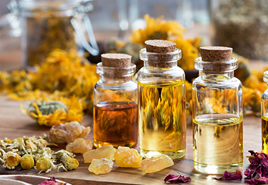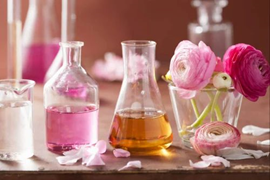Perfume is a delightful blend of aromatic essential oils and fragrance compounds, carefully crafted to produce an appealing scent. Perfume chemistry is based on how our sense of smell works. Our noses are equipped with olfactory receptors that bind to specific molecules in the air. When these molecules bind to the receptors, they send a signal to the brain, which interprets the signal as a smell.

Figure 1: Olfactory receptors responsible for the sense of smell.
Each Compound Trigger a Specific Smell Sensation. Perfumes may contain of an average of 200 different chemical compounds. Depending on the high percentage of certain molecules the sent in interpreted by our brain to specific smell. For example, lilies contain many compounds but the main three compounds responsible for their smell are: linaool, ocimene and myrcene.
Some of the common compounds used in perfumes are:
Benzyl alcohol is a sweet-smelling compound that is often used in floral perfumes.
Ethyl acetate is a fruity-smelling compound that is often used in citrus perfumes.
Benzaldehyde is a spicy-smelling compound that is often used in oriental perfumes.

Figure 2: Compounds name from the left to the right are benzyl alcohol, ethyl acetate, benzaldehyde, formaldehyde and methyl anthranilate.
Formaldehyde is a pungent-smelling compound that is often used as a fixative in perfumes.
Methyl anthranilate is a grape-like smelling compound that is often used in fruity perfumes.
What Are the Basic Components Used in Preparing Perfumes?
- Compounds that are responsible for fragrance: Essential oils and aroma chemicals.
- Components responsible for applying perfumes: solvents/base, carrier oils, fixatives, solubilizers and accents and additives
Compounds that are responsible for fragrance:
1. Essential Oils: These are natural, highly concentrated oils extracted from plants, flowers, fruits, and other botanical sources. Essential oils contain many organic compounds that are responsible for the distinct scents of various plants as the three compounds responsible for the smell of lillies.

Figure 3: Essential oils are natural, highly concentrated extracted oils.
2. Aroma Chemicals: Also known as fragrance compounds or synthetic aroma molecules, these are laboratory-created ingredients that mimic or enhance natural scents. Aroma chemicals offer a wide range of smells and help create complex and unique fragrance compositions.

Figure 4: Aroma chemicals help to enhance the natural scents.
Components responsible for applying perfumes
3. Solvents/bases: Perfumes need a liquid base to dissolve and dilute essential oils and aroma chemicals. Solvents, such as alcohol (ethanol), are commonly used to create perfume’s liquid carrier. The solvent also evaporates upon application, allowing the fragrance to disperse.

Figure 5: The structure of ethanol and propylene glycol.
4. Carrier oil: A carrier oil, also known as a base oil or vegetable oil, is a non-volatile oil used to dilute essential oils and other concentrated substances. Carrier oils act as a medium to dilute the potency of essential oils while allowing them to be spread easily over a larger area of the skin. Some common carrier oils include jojoba oil, almond oil, and grapeseed oil.

Figure 6: Oil carriers are less oils with less fragrance than extracted fragrance oils.
5. Fixatives: Fixatives are substances that slow down the evaporation of perfume, ensuring that the scent lingers on the skin for a longer time. They also help blend and stabilize perfume components. Common fixatives include musk, ambergris, and vanillin.

Figure 7: Amber and Ambergris slow down the perfume evaporation.
6. Solubilizers are substances that aid in dissolving and dispersing fragrance oils in the diluents or solvents. They ensure that the fragrance compounds are evenly distributed throughout the perfume. Solubilizers are particularly useful when the fragrance compounds have limited solubility in the chosen solvent. They form stable micelles or complexes with the fragrance oil, allowing them to become dispersed or dissolved. Solubilizers include certain alcohol-based or oil-based emulsifiers. Some of common solubilzers are: polysorbate 20, benzyl benzoate cyclodextrins and propylene glycol. Notice that propylene glycol can be used as a base and solublizer.

Figure 8: Polysorbate 20 is used to ensure the evenly distribution of oils.
7. Accents and Additives: Perfume formulations may also include additional ingredients to add unique touches or enhance specific aspects of the fragrance. These can include natural or synthetic additives, such as floral extracts, citrus oils, spices, or aromatic herbal extracts.

Figure 9: Herbal extracts and spices give perfume a unique signature.